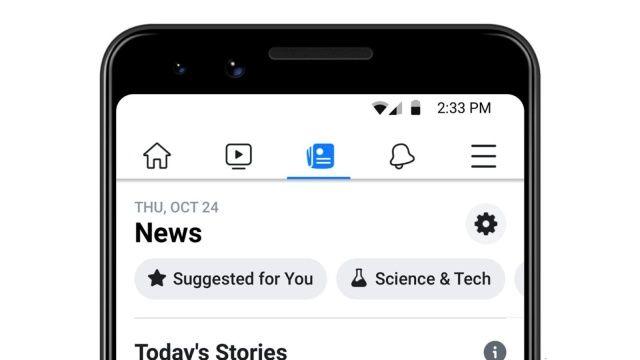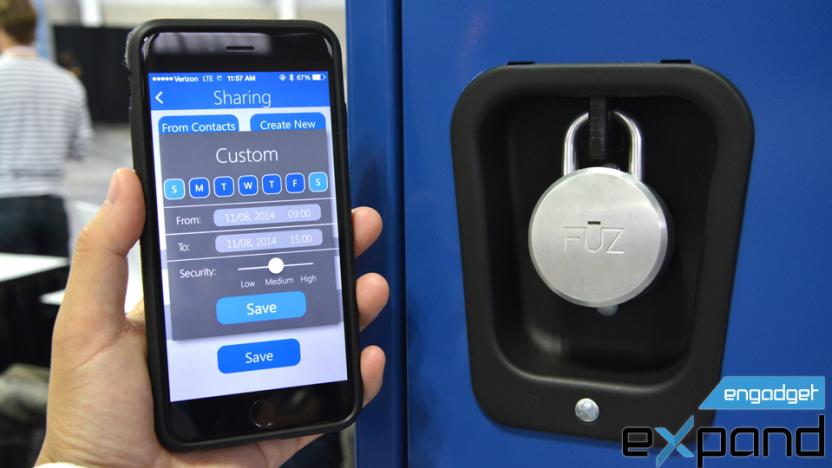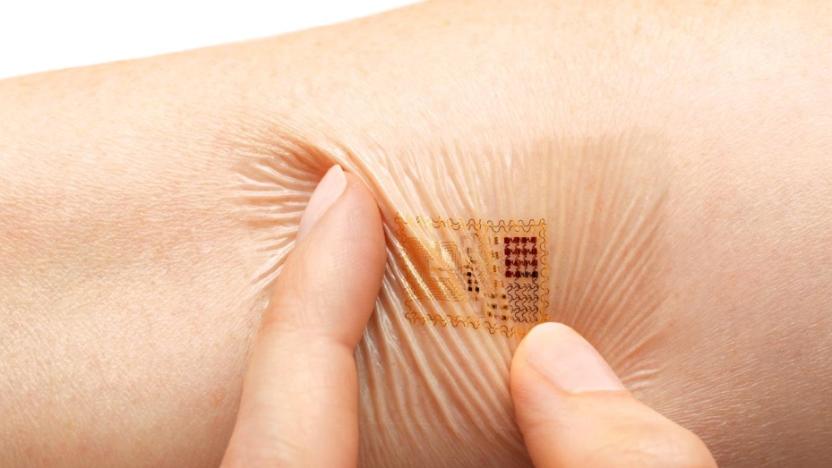expand
Latest

Facebook is expanding its dedicated news section to more countries
Facebook plans to expand its News section outside the US in the next six to 12 months.

Congratulations to our Insert Coin winners: Poursteady and Noke
The votes have been tallied; the judges deliberated; and we have our winners for this year's Insert Coin. The judges tossed their support behind Poursteady, a robot that makes five pour-over cups of coffee and handed the company $10,000 to help get off the ground. Noke took home the $15,000 readers choice prize. While we've seen plenty of smartlocks before, this is the first time we've seen Bluetooth crammed into the padlock form factor. You can relive the entire competition, from the initial presentations by the 10 semi-finalists, to the grilling by the judges, and finally the prizes being awarded after the break.

Cute robots make good filmmakers and maybe better companions
What is the last risk you took? Who do you love most in the world? If you died tomorrow, what would you regret the most? Posing those questions to your friends would probably net you a snide rejoinder, and a stranger would walk away in a huff (if you were lucky). Artist and engineer Alexander Reben wanted to explore what kinds of relationships could arise between humans and robots, so he did the only logical thing: he and his team build a legion of cute machines to ask those very questions.

A colony on Mars will be the 'next giant leap for mankind'
Bas Lansdorp, CEO and co-founder of Mars One, is nothing if not ambitious. His dream is the stuff of science fiction -- not only does he want to put humans on Mars in 2025, but he wants to leave them there to establish a self-sufficient settlement. And he plans to fund the enterprise, in part, by televising everything from pre-mission training to daily life on the Red Planet. Or as much as the colonists want us to see, anyway, as they'll ultimately be in control. As you can imagine, he's a pretty interesting guy to talk to, which is why we were psyched to have him on the Engadget Expand stage to articulate his vision, and what he hopes it'll mean for humanity.

3D printing is venturing beyond plastic and into your home
When you think of what 3D printing can do, you probably imagine simple plastic models and parts -- clever, but not exactly revolutionary. If you ask Dovetailed's Vaiva Kalnikaite and Make's Anna Kaziunas France, however, they'll tell you that 3D printers can accomplish much, much more. Dovetailed's 3D-printed fruit is just the start of what you can do with food, for example. Kalnikaite told Engadget Expand guests that 3D printing offers not just extra creativity with how you present meals, but a way to change the meals themselves. Do you like the taste of bananas, but not their texture? You could print food that offers everything you like, and nothing you don't. This could be particularly helpful if you have a food allergy, since you could enjoy food that was previously off-limits.

DARPA goes beyond killer robots with prosthetics and Ebola research
DARPA, the military's mad science division, is also a master of PR -- we all cheer them on, even though they may be building a robot army that one day hunts us down (kidding!) There's a lot more to the Agency than robotics work, however. DARPA was actually founded to "prevent technological surprises" of any kind after the Soviets launched Sputnik in 1957. As a result, it also supports projects peripherally related to defense, like Ebola research, brain-controlled prosthetics and space exploration. Here at Engadget's Expand NY, we sat down with Director Arati Prabhakar to learn about how its pushing boundaries with its, shall we say, less terrifying work.

60 seconds with Hemingwrite, an E Ink typewriter
Between social networks, video games and the endless void of procrastination we call "the internet," computers can make pretty poor writing devices. Isn't there something better? Insert Coin contenders Adam Leeb and Patrick Paul think so -- they've created the Hemingwrite: an E Ink typewriter that does almost nothing, save text entry. It's a minimalist writing machine that features a machine-tooled aluminum chassis, a satisfying mechanical keyboard and a six-week battery life. It's not completely devoid of modern faculties, however: it also automatically uploads your prose to a cloud storage system as you type it.

60 seconds with the world's first Bluetooth padlock
In just a matter of three months, the Noke smart padlock managed to make its way from Kickstarter to our Expand event as an Insert Coin contender, so of course it's rather special. First of all, it's a Bluetooth 4.0-enabled steel bolt that can be unlocked with a click on the shackle when your iPhone or Android phone is nearby. Secondly, the companion app lets you share your Noke locks with family and friends, thus saving you the hassle of passing on a physical key. You can even set the repetition and security level for the authorization, as well as tracking history by users or by locks.

60 seconds with a simple but smart home monitoring device
There are already plenty of ways to keep an eye on your abode from afar, so any new home monitoring product better have a fresh approach if it wants to stand out from the competition. For start-up Form Devices, the goal wasn't to create an elaborate, connected home security system that did more than existing products, but to make something simple, affordable and user-friendly. And, it must've done something right with its Point home monitoring device, which cruised past its $50,000 Kickstarter goal just two days after the campaign went live, and is now participating in our Insert Coin competition at Engadget Expand. The plain white, palm-sized puck hosts sound, humidity, temperature, air quality and particle sensors, but no camera. This was a very intentional omission, not just because Point is supposed to be small and inconspicuous, but so users have peace of mind that nobody will ever be watching them.

WiTricity's CEO paints a picture of a wirelessly powered future
If WiTricity CEO Alex Gruzen gets his way, the company's tech will soon wind up in your phone, your car and even inside your body. That's because the Massachusetts-based company deals in magnetic resonance technology, and if those words don't mean anything to you now, they probably will before long. You see, WiTricity has been working for the past five years on a way to wirelessly transfer power between devices, and Gruzen told our audience at Engadget Expand NY that the wireless future is basically right around the corner.

Taking apart Google's modular smartphone
What do you want to know about Project Ara? Does a modular smartphone actually work? Yes. Is it very different from Android phones? In a basic how-a-phone-all-works, yes indeed. Paul Eremenko, Technical Project Lead on Google's modular phone project just called in at Expand NY, and he brought along the latest working prototype. Modular phones do indeed work: you can take out a component without bricking the device, it can already run Angry Birds and we just got to play with one.

60 seconds with the team that wants to make every car smart
Wouldn't it be great if you could change your car's head unit as frequently as you do your smartphone? Enter Onics, a startup that's crafted a dashboard-mounted module that lets you turn your phone into your car's nerve center. Essentially, the hardware's just a double-din unit with a locking clip up front, that'll accept any Android or iOS smartphone that's up to six inches in size. Rather than trailing a power wire from the 12V socket, there's a built-in microUSB or Lightning port, and if your vehicle supports it, you'll even be able to start the car with your mobile.

60 seconds with the wearable that might save your back
This Insert Coin contender could well cure what we call "Engadget back": the slightly unappealing hunch that some editors (read: this editor) descend into after typing away at one too many articles or trade shows. The Upright sticks (through a hypoallergenic adhesive strip) to the small of your back, where it uses multiple sensors -- an accelerometer and a strain gauge -- to monitor the line of your spine -- and tell you through gentle vibrations when you're doing it wrong. We just tested it briefly here at Expand, and the reminder vibrations are far more gentle than, say, your smartphone. It kinda feels like soda water on your skin: enough to remind you that you're slouching but not enough to grate. The team behind it reckons that 15 minutes a day will be enough to reeducate your back muscles and a Bluetooth connection links the device to your smartphone to keep everything recorded for future posterity.

60 seconds with a giant, rollable display for your mobile devices
At some point, you've probably wished that your smartphone had a much larger screen to watch a movie or get work done... but you can't always lug a desktop display or tablet around, can you? If Insert Coin finalist RollRR has its way, you won't have to. It's developing rollable displays that would give your mobile devices a lot more visual real estate without consuming much space in your bag. The prototype on the Engadget Expand show floor is a 10.7-inch roll of e-paper attached to a giant tube, but the ultimate goal is to fit a 21-inch or larger screen (ideally, full color plastic OLED) into a gadget the size of a small umbrella. It's also considering touch technology like 3M's silver nanowires, so RollRR could expand your input area, too -- you could edit a large image on your phone just by unrolling the sheet on a table.

60 seconds with a modular drone that packs a pro camera
We're entering a golden age of UAVs, with models ranging from hobbyist drones like the Parrot AR Drone 2.0 all the way up to DJI's DSLR-packing Spreading Wings S900 Hexacopter. So what could our Insert Coin semi-finalist drone possibly bring to the party? Ivan Stamatovski said he created the EasyDrone for one simple reason: portability. Unlike most commercial drones, the EasyDrone can be broken down into a relatively compact case and easily assembled without having to connect any wires. At the same time, it comes with all the capability of a high-end drone: video streaming, a built-in gimbal, the ability to carry heavier cameras like Sony's NEX models and a high-end navigation system from 3D Robotics.

Five things we learned from robotics expert Mark Setrakian
Mark Setrakian has been working with robotics and animatronics for a while -- starting at 19 and working at Industrial Light & Magic. If you've seen Men In Black, Hellboy or even Pacific Rim, then you've seen some of his creations. He's also a former heavyweight champion of Robot Wars and the man behind Robot Combat League's metal fighters. Who better, then, to come onstage at Expand NY (the show starts today!) and explain how robotics make it onto the big screen, how to ensure it all looks the part and what challenges still remain. However, before all that, we've asked him to explain what he's learned from roughly two decades of making inanimate things come to life.

Five questions for the man making contactless wireless power a reality
With wireless power demos and proposals going as far back as 2006, what's taking so long? And, most importantly, is it safe? At Engadget Expand, we'll be addressing these questions with WiTricity CEO Alex Gruzen, who will also share his thoughts on the industry.

Five questions about VR beyond gaming with three people making it happen
Looking at Facebook, Sony and Samsung, you might think the future of virtual reality is all entertainment and social interaction. While video games and movie watching are both primary components of the recent virtual reality wave, there's much more to the field. Matterport, a company focused on 3D-mapping tech, and BeAnotherLab, the group behind interactive art installation "The Machine to be Another" -- are each pushing forward virtual reality, and neither are focused directly on game-like interactive immersion. The medium of virtual reality is young, but it is already varied. So, what does the future hold? We asked five questions surrounding that subject to three people who are shaping that future: the panelists for our "Back to Reality: VR Beyond Gaming" panel at Expand 2014 (which starts tomorrow!). Head below for their answers!

Five questions about the future of drones with 3D Robotics' Colin Guinn
Everyone, it seems, is talking about drones these days. Whether it's for industry, research or performance art, the skies have never been busier. Thanks, in no small part, to the ever-increasing number of consumer-friendly, ready-to-fly quadcopters. Colin Guinn left DJI to join one of the biggest names in commercial drones -- 3D Robotics -- as SVP of sales and marketing. If anyone knows about the future of our skies, it's him. I'll be speaking with Guinn at Expand on Saturday, November 8th, about the future of commercial, personal and hobby drones -- with maybe a little onstage flying going on, too. Before that though, read on to get a little primer on the buzzing topic from the man himself.

Five questions for the athletes making wearables you won't take off
MC10's most notable projects -- the Checklight head-impact tracker that protects athletes from the effects of dangerous collisions and a Biostamp "seamless sensing sticker" -- are already at the forefront of sports and medicine technology. Isaiah Kacyvenski and Angela Ruggiero are experienced athletes on the company's sports advisory board, tasked with figuring out ways to use technology to optimize athletic performance. That's certainly great news if you're an athlete in an impact sport trying to avoid the after effects of concussions, or a blogger getting punched in the face by your coworkers. But what about everyone else? Kacyvenski and Ruggiero will join me at Engadget Expand on November 8th for a discussion on how the new technology can help us stay healthy, and ensure that our workouts are refined to get the most impact. You can tune in or attend the event for free, but check after the break for a quick preview, and let us know if you have any questions that need answering.












